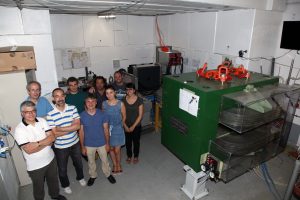 One of the most fascinating frontiers of fundamental physics is undoubtedly the search for dark matter, or that 27% of all the universe matter of which no direct interactions with ordinary matter have been detected.
One of the most fascinating frontiers of fundamental physics is undoubtedly the search for dark matter, or that 27% of all the universe matter of which no direct interactions with ordinary matter have been detected.
With various techniques, trying to confirm or deny the different hypothesis formulated by theoretical physicists, in the major laboratories all over the world, a veritable “hunt” for this kind of invisible matter is carried out. Several experiments at CERN, as well as at Gran Sasso Laboratories or Jefferson Lab in the United States, are looking for a signal which may help to clarify the cosmological evidences of dark matter.
The underlying hypothesis of the PADME experiment – starting these days its data-taking at LNF – is that dark matter is sensitive to a new type of force which falls outside the four fundamental interactions we know (gravitational, electromagnetic, strong and weak), to which it would be associated a “messenger”, similar to the electromagnetic waves photon, but with a mass not null (even if small).
PADME experimental technique is meant to search for this new particle among the products of the annihilations of the positrons (the electron antiparticles) produced by the Frascati linear collider, with the electrons of the atoms of a very subtle target. In some rare events, almost all the available energy should be acquired by the dark photon at the expense of its “twin” ordinary photon which is produced in this kind of reaction too: e+ e– -> gamma A’, where gamma indicates the ordinary photon while A’ the dark one that would remain invisible also in its successive decays into dark matter particles.
PADME experimental apparatus is capable of measuring the energy and the position of the (ordinary) photon with high precision and therefore the “signature” of this type of events in the form of a peak in the missing energy (or, is equivalent, the missing mass). So PADME’s main detectors are calorimeters, tools able to measure, with excellent resolution, the energy of the photons (and of the electrons) detecting the scintillation light produced by the passage of the particles.
PADME has two separate calorimeters: the first is made of a 600 BGO crystals matrix, the second one, built with 25 lead fluoride crystals, using the emission of Cherenkov radiation, is capable to measure with great precision not only the energy, but also the arrival time of the particles.
The experiment is taking data on the BTF beamline (Beam-Test Facility) since July and it will go on until the end of the year, with the objective of reaching a sensitivity of 1/1000 in the coupling constant between the dark photon and the ordinary one, accumulating 10.000 billion of annihilation interactions.
Translation by Camilla Paola Maglione, Communications Office INFN-LNF
 INFN-LNF Laboratori Nazionali di Frascati
INFN-LNF Laboratori Nazionali di Frascati